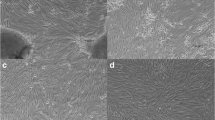Abstract
Two cell lines have been established from juvenile pilchards (Sardinops sagax neopilchardus) caught in waters off the Victorian coast of Australia. Following establishment of primary cultures derived from different pilchard tissues, using various cell culture media, a pilchard liver (PL) cell line and a pilchard heart (PH) cell line have been maintained in Eagle’s minimal essential medium supplemented with 10% foetal bovine serum for over four years. The cell lines have been cryopreserved in liquid nitrogen and can be recovered from storage with good cell viability. Stock cell cultures have been maintained at 20–22 °C on a continuous basis in normal atmosphere (100% air), with weekly subculture at a split ratio of 3:1. The origin of the cell cultures was confirmed by PCR analysis using primers designed to be specific for pilchard mitochondrial DNA. In addition, the liver cell line was cloned and both the parental cell line and clones thereof were shown to be susceptible to a broad range of marine and freshwater viral pathogens of fish.
Similar content being viewed by others
References
Altschul SF, Madden TL, Schäffer AA, Zhang J, Zhang Z, Miller W, Lipman, DJ (1997). Gapped BLAST and PSI-BLAST: a new generation of protein database search programs. Nucl Acids Res 25: 3389–3402
Chang SF, Ngoh GH, Kueh LFS, Qin QW, Chen CL, Lam TJ, Sin YM (2001). Development of a tropical marine fish cell line from Asian seabass (Lates calcarifer) for virus isolation. Aquaculture 192: 133–145
Crane MStJ (1999). Mutagenesis and cell transformation in cell culture. Meth Cell Sci 21: 245–253
Crane, MStJ, Hardy-Smith P, Williams LM, Hyatt AD, Eaton LM, Gould A, Handlinger J, Kattenbelt J, Gudkovs N (2000). First isolation of an aquatic birnavirus from farmed and wild fish species in Australia. Dis Aquat Org 43: 1–14
Fernandez RD, Yoshimizu M, Kimura T, Exura Y (1993). Characterisation of three continuous cell lines from marine fish. J Aquat Animal Hlth 5: 127–136
Fijan N, Sulimanovic D, Bearzotti M, Muzinic D, Zwillenberg LO, Chilmonczyk S, Vautherot JF, de Kinkelin P (1983). Some properties of the Epithelioma Papulosum Cyprini (EPC) cell line from carp (Cyprinus carpio). Ann Virol (Inst Pasteur) 134E: 207–220
Freshney RI (1994). Culture of Animal Cells–a Manual of Basic Techniques (3rd ed.) Wiley-Liss, New York
Fryer JL, Lannan CN (1994) Three decades of fish cell culture: current listing of cell lines derived from fishes. J Tissue culture Methods 16: 87–94
Ganassin RC, Sanders SM, Kennedy CJ, Joyce EM, Bols NC (1999). Development and characterization of a cell line from Pacific herring, Clupea harengus pallasi, sensitive to both naphthalene cytotoxicity and infection by viral hemorrhagic septicemia virus. Cell Biol Toxicol 15: 299–309
Hyatt AD, Hine PM, Jones B, Whittington R, Kearns C, Wise TG, Crane MS, Williams LM (1997). Epizootic mortality in the pilchard Sardinops sagax neopilchardus in Australia and New Zealand in 1995. II. Identification of a herpesvirus within the gill epithelium. Dis Aquat Org 28: 17–29
McFarland DC (2000). Preparation of pure cell cultures by cloning. Meth Cell Sci 22: 63–66
Mulford AL, Lyng F, Mothersill C, Austin B (2001). Development and characterisation of primary cell cultures from the hematopoietic tissues of the Dublin Bay prawn, Nephrops norvegicus. Meth Cell Sci 22: 265–275
Nicholson BL (1985). Techniques in fish cell culture. In: Techniques in the Life Sciences, C1. Setting Up and Maintenance of Tissue and Cell Cultures, C105:1–16
Perez-Prieto SI, Rodriguez-Saint-Jean S, Garcia-Rosado E, Castro D, Alvarez MC, Borrego JJ (1999). Virus susceptibility of the fish cell line SAF-1 derived from gilt-head seabream. Dis Aquat Org 35: 149–153
Qin QW, Lam TJ, Sin YM, Shen H, Chang SF, NgohGH, Chen CL (2001). Elec tron microscopic observations of the marine fish iridovirus isolated from brown-spotted grouper, Epinephelus tauvina. J Virol Meth 98: 17–24
Watanabe Y, Hanada H, Usiyama M (1981). Monolayer cell cultures from marine fishes. Fish Pathol 15: 201–205
Whittington RJ, Jones JB, Hine PM, Hyatt AD (1997). Epizootic mortality in the pilchard Sardinops sagax neopilchardus in Australia and New Zealand in 1995. I. Pathology and epizootiology. Dis Aquat Org 28: 1–15
Author information
Authors and Affiliations
Corresponding author
Rights and permissions
About this article
Cite this article
Williams, L.M., Crane, M.S.J. & Gudkovs, N. Development and characterisation of pilchard (Sardinops sagax neopilchardus) cell lines derived from liver and heart tissues. Methods Cell Sci 25, 105–113 (2004). https://doi.org/10.1007/s11022-004-9801-5
Revised:
Issue Date:
DOI: https://doi.org/10.1007/s11022-004-9801-5




